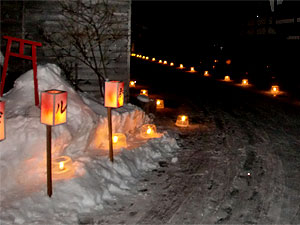>> Atomic Bomb Fires are Still Burning
Silently--Candle Night 1 Pi:ce
>> Ice Candles Shedding the Lights on Snowy Towns
>> Feeling comfortable and part of Nature--Walking in the dark by Jun Nakano
>> A Ceremony to Send Insects Off --"Mushi Okuri"
>> Candle Night with Turban Shells and Waste Cooking Oil
>> Message Sent from Antarctica--Candlescape
>> Beautiful Fireflies Glowing in the Dark
>> Dialogue in the Dark
>> Many People Enjoyed Candle Night--Candle Night Saskatchewan, Canada
>> Candle Night in Zenryouji Temple--'Go home make a wish'
>> Recreating Ancient Night of 'Heian' Dynasty--Lights-down at Kyoto Gyoen Forests
>> Luminaria di Santa Croce--A Festival in Italy
>> Brighten up Afghanistan with Used Candles
>> Candles for Hope and Courage--Relay For Life 2007 in Ashiya, Hyogo
>> A Family's Wishes on Candle Night--The Story of Ivory
>> Lights in Terraced Rice Paddy Field--Minamata, Japan
>> Candle Night on YouTube
>> Easter in Romania
>> Lucia Celebration in Sweden
>> Milk Carton Lanterns Lighting up Kumamoto
>> Beeswax candle workshop and volunteer meeting at JFS
>> Star Festival in Hokkaido
>> The Red Candles and the Mermaid
Ice Candles Shedding the Lights on Snowy Towns

copyright Kisoji.com
Ice candle festivals are held across snowy regions in Japan, such as Hokkaido and Nagano Prefecture, where the temperatures dip to their lowest in January and February. The areas endure severe cold and are covered with heavy snow from November until around March.
Ice candle holders are made of ice. Beautiful flickering candlelight through the ice holder lights up the snow-covered towns. To make the holder, first fill a bucket with water and leave it outside overnight to freeze, remove the ice from the bucket when the edges are frozen and drain the remaining water.
In this issue of the Candle Night Newsletter, we would like to share a story about a Naraijuku Ice Candle Festival in the Kiso area, which extends from Nagano to Gifu Prefectures.
In the Edo Period (1603-1868) in Japan, the five famous post roads known as Go-Kaido were built. They started at the Nihonbashi Bridge in Edo (present Tokyo), and connected to other areas. Nakasendo, one of the five roads, was completed in 1694. Sixty-nine post stations were placed along the road from Nihonbashi to Otsujuku (Otsu station, present Otsu City in Shiga Prefecture). The stations from Niekawajuku (present Shiojiri City in Nagano Prefecture) to Magomejuku (present Nakatsukawa City in Gifu Prefecture) are known as 11 stations of the Kisoji, an old trade route in the Kiso Valley. The area is located in the mountainous area with a variety of landscapes.
An ice candle event called "Kisoji Hyosetsu Himatsuri 2010 (Light-Up Festival in Snow and Ice)" was held from January 29 to February 13, 2010 in the area which still has the air of old post stations.
Fifteen places including eleven at Kisoji post stations, three at the foot of Mount Kiso-Ontake and one at Kiso-Hirasawa held a series of ice candle events.
The Naraijuku Ice Candle Festival held its 12th event on February 3, 2010, and is the oldest ice candle festival in Kisoji.
http://www.kisoji.com/kisoji/event/event_detail/2010hyousetsu/index10_07.html(Japanese)
Naraijuku Station (present Shiojiri City in Nagano Prefecture) is halfway through the Nakasendo, located at the highest altitude out of the 11 stations. The Torii pass, known as one of the hardest mountain passes for travelers, lies just beyond this station. It used to be the busiest station in Kisoji where many travelers came and went during the Edo Period. The old town scenery is still treasured and the houses show flavors of the old-time station, extending for about one kilometer along the Naraigawa River.
To prepare for the event, residents of the town spent almost a week making ice candle holders. On the day of the ice candle festival, about 3,000 ice candles were placed along the street. Many tourists enjoyed walking through the town in the gentle candlelight, as if they were experiencing the Edo Period.
Kunimoto Wada of the Shiojiri City Tourist Association said, "We had a bean-throwing event (a traditional seasonal event to turn evil away by throwing beans) on the same day since it was the Setsubun (the traditional end of winter), but we enjoyed our town scenery the most after the festival. House lights were turned off, so it was dark except for the candlelight. It took a while for the ice holders to melt, but we enjoyed watching them melt little by little, changing shape. "
The ice candle festival has become one of the most popular sights at the historic post stations.
(Taeko Ohno)
March 19, 2010








